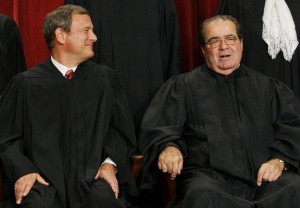Reagan Republicans, skillful and abundantly financed, fought their way back from defeat. Rejecting the conservatism of Eisenhower-style Republicanism, which tended to respect the established norms of cultural tradition while seeking to serve the interests of business, they visualized an agenda for the Supreme Court of their dreams, which Jeffrey Toobin, in his 2007 book The Nine, neatly summed up: “Reverse Roe v. Wade and allow states to ban abortion. Expand executive power. End racial preferences intended to assist African-Americans. Speed executions. Welcome religion into the public sphere.”
To promote that agenda, they fashioned a compelling narrative based on a judicial philosophy called “originalism” and espoused by the intellectual soulmates of Bork, whom they reinvented as a martyr to leftist extremism. The task of Supreme Court justices was to stick to the text of the Constitution as faithfully as a fundamentalist clergyman to the word of God as revealed in Scripture. The words of the founding fathers should be applied precisely as they had understood them in 1787, in order to divine their “original intent.”
The effort to find “rights” not explicitly mentioned in the Constitution in order to expedite the purposes listed in the preamble — such as promoting the general welfare and establishing justice — was, in Bork’s view, a “heresy” practiced by liberal justices trying to cram radical social programs down the nation’s gullet. Never mind that said preamble seems to define that “original intent” more clearly and eloquently than any other source; after all, the framers wrote it.
Donning the robes and language of populism, the originalists insisted that wicked liberals who “made” new constitutional law were stealing the prerogative of the people to see their will enacted into law by elected representatives. Convincing as this was to the conservative mindset, it isn’t quite that simple. The court today is far from a collection of neutral arbiters: it is divided almost equally along partisan lines. Of the four remaining reliably liberal justices, two were named by Clinton and two by Obama. Then there are two chosen by Reagan, one by the first President Bush, and two by George W. Bush. In important cases decided five to four, it is usually the Republican-chosen quintet that provides the victory.

Chief Justice John Roberts, left, and Associate Justice Antonin Scalia sit for a new group photograph, Tuesday, Sept. 29, 2009. (Photo by Charles Dharapak/AP)
Of course, many decisions do not follow a precise pattern; there are shifting alliances and surprising switches. But two facts stand out. One is that the “strict construction” members seem to have no trouble with ideological inconsistency. Chief Justice Roberts, in his confirmation hearings, announced that the justices were not to be rulemakers but merely “umpires,” while neglecting to mention that, although he was not among them, the “umpires” in Bush v. Gorehad called the game before it was over and awarded victory to the team they favored. Nor is it believable that justices who, like the dogmatic and authoritarian Scalia, freely admit in their opinions to a loathing of abortion or homosexuality have not let those deeply religious prejudices seep into their readings of the Constitution. Or that, when any of the justices defer to sweeping new executive powers in the presidentially launched and conducted “war on terror,” they aren’t aware that they are flatly contradicting the crystal-clear intention of the framers to avoid giving any president the authority of a monarch.
The right-wing counterrevolution promoted by Reagan set out to remake the judiciary in its own image. By now, it has almost completely succeeded. One evident proof of its achievement is the tendency of the Roberts Court to affirm the rights of property and organized wealth — especially of corporations — over the individual or the public interest in almost any contest with regulators or victims of abuse. Now, with its Citizens United decision, which virtually permits corporations to buy the government they desire through an election process incredibly and needlessly voracious for money, the Court has given a jet-powered boost to the move toward plutocratic control over our lives and fortunes.
Once again, history rhymes. One of the court’s greatest blunders was the 1857 Dred Scott decision, which legitimized the spread of slavery through all the territories destined for future statehood, thwarting expectations that “the peculiar institution” was on a gradual road to extinction. Outrage at the prospect of permanent dominance by the Slave Power spurred the election of Abraham Lincoln and the Civil War. It is no exaggeration to say that Citizens United creates the threat of our subjugation to a Money Power, against which democracy must struggle for its very life.
This is why the arbitrary and uncontested power of the Supreme Court is the subject of this special issue of The Nation. The moral: Elections matter. Does anyone think Barry Goldwater would have chosen Thurgood Marshall for the Supreme Court? Or John Kerry, Samuel Alito?
But the battle is on many fronts, and will be won not only by voters on election day but by citizens engaged at every level of democracy and in every peaceful form of protest. The nation imagined by its founders — those authors of “We the People,” who clearly intended this experience in self-government to include the many, not just the privileged few — is under siege by extraordinary concentrations of corporate power and private wealth, aided and abetted by an autocratic judiciary. There can be only one response to this usurpation of democracy: defiance.
So read on, sign on and join the resistance.
Bill Moyers and Bernard Weisberger, who has taught history at the University of Chicago and the University of Rochester, are longtime collaborators on books and television series, including A Walk Through the 20th Century and Report From Philadelphia: The Constitutional Convention of 1787. They are now working onThe Fighting Spirit: The People vs. The First Gilded Age.

